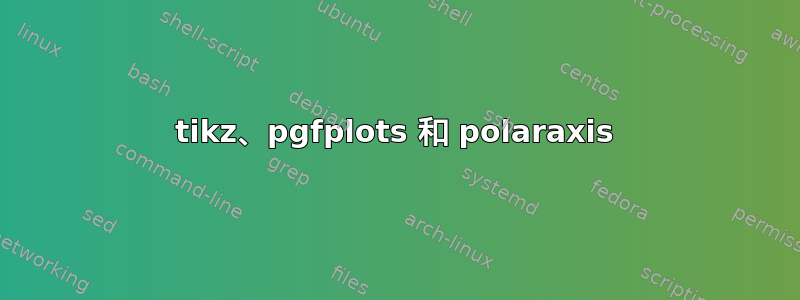
我找到了一个不错的极坐标图模板1我做了如下调整:
\documentclass[12pt]{standalone}
\usepackage[x11names]{xcolor}
\usepackage{tikz}
\usepackage{pgfplots}
\begin{document}
\huge
\begin{tikzpicture}
\edef\val{0}
\foreach \a in {0, 1,...,359}
\draw[Azure4] (\a:9.7) -- (\a:10);
\foreach \a in {0, 5,...,359}
\draw[Azure4] (\a:9.5) -- (\a:10);
\foreach \r in {5,6,...,9}
\draw[black!45] (0,0) circle (\r);
\draw[black, ultra thick] (0,0) circle (10);
\foreach \r in {5, 6,...,10}
{
\draw (\r,0) node[inner sep=1pt,below=3pt,rectangle,fill=white] {$\val$};
\pgfmathparse{int(\val+1)}
\xdef\val{\pgfmathresult}
}
\draw (7.5,0) node[inner sep=1pt,above=3pt,rectangle,fill=white] {wear (mm)};
\foreach \a in {0, 90,...,359}
\draw[very thick] (\a:5) -- (\a:10);
\draw (0: 10.5) node {$0$};
\draw (90: 10.5) node {$\pi/2$};
\draw (180: 10.5) node {$\pi$};
\draw (270: 10.5) node {$3\pi/2$};
\draw[fill=red] (0,0) circle(1.1mm);
\end{tikzpicture}
\end{document}
我想从这个空白图中添加一些从外部文本文件读取的数据,比如说data.txt。
到目前为止,我发现包含外部数据的唯一方法与命令有关\addplot,因此我正在考虑使用环境polaraxis。
该文件data.txt包含两列,例如:
t u
0 1
20 2
40 3
60 4
100 5
130 4
160 3
180 2
220 2
240 3
260 3
290 3
300 1
320 1
360 1
360 10
360 1
首先,为了读取数据我使用:
\usepgfplotslibrary{polar}
\pgfplotstableread{data.txt}\data
然后在 tikzpicture 中创建我的极轴环境:
\begin{polaraxis}[%
xmin=0, xmax=360,
xtick={},
xticklabels={},
xticklabels={},
xlabel={},
ylabel={},
yticklabels={},
axis lines = none,
filter discard warning=false,
axis on top]
\addplot [color=blue,each nth point=1,very thick] table [x=t,y=u] {\data};
\end{polaraxis}
我最终得到了这个图表:

我的问题是:(1)我怎样才能使 和 我的 tikzpicture 具有相同的来源polaraxis,以及(2)我可以使用\draw命令直接读取我的数据而不使用polaraxis和\addplot吗?
1 http://www.texample.net/tikz/examples/polar-coordinates-template/
答案1
它们都应该在相同的 tikzpicture环境。
\documentclass[12pt]{standalone}
\usepackage[x11names]{xcolor}
\usepackage{tikz}
\usepackage{pgfplots,pgfplotstable}
\usepgfplotslibrary{polar}
\pgfplotstableread{
t u
0 1
20 2
40 3
60 4
100 5
130 4
160 3
180 2
220 2
240 3
260 3
290 3
300 1
320 1
360 1
360 10
360 1
}{\data}
\tikzset{mypic/.pic={%
\begin{scope}[x=1cm,y=1cm]
\edef\val{#1}
\foreach \a in {0, 1,...,359}
\draw[Azure4] (\a:9.7) -- (\a:10);
\foreach \a in {0, 5,...,359}
\draw[Azure4] (\a:9.5) -- (\a:10);
\foreach \r in {5,6,...,9}{
\draw[black!45] (0,0) circle (\r);
}
\draw[black, ultra thick] (0,0) circle (10);
\foreach \r in {5, 6,...,10}
{
\draw (\r,0) node[inner sep=1pt,below=3pt,rectangle,fill=white] {$\val$};
\pgfmathparse{int(\val+1)}
\xdef\val{\pgfmathresult}
}
\draw (7.5,0) node[inner sep=1pt,above=3pt,rectangle,fill=white] {wear (mm)};
\foreach \a in {0, 90,...,359}{
\draw[very thick] (\a:5) -- (\a:10);
}
\draw (0: 10.5) node {$0$};
\draw (90: 10.5) node {$\pi/2$};
\draw (180: 10.5) node {$\pi$};
\draw (270: 10.5) node {$3\pi/2$};
\draw[fill=red] (0,0) circle(1.1mm);
\end{scope}
}
}
\begin{document}
\huge
\begin{tikzpicture}
\begin{polaraxis}[%
xmin=0, xmax=360,clip=false,
xtick={},
xticklabels={},
xticklabels={},
xlabel={},
ylabel={},
yticklabels={},
axis lines = none,
filter discard warning=false,
axis on top]
\addplot [color=blue,each nth point=1,very thick] table [x=t,y=u] {\data};
\pic {mypic={0}};
\end{polaraxis}
\end{tikzpicture}
\end{document}



